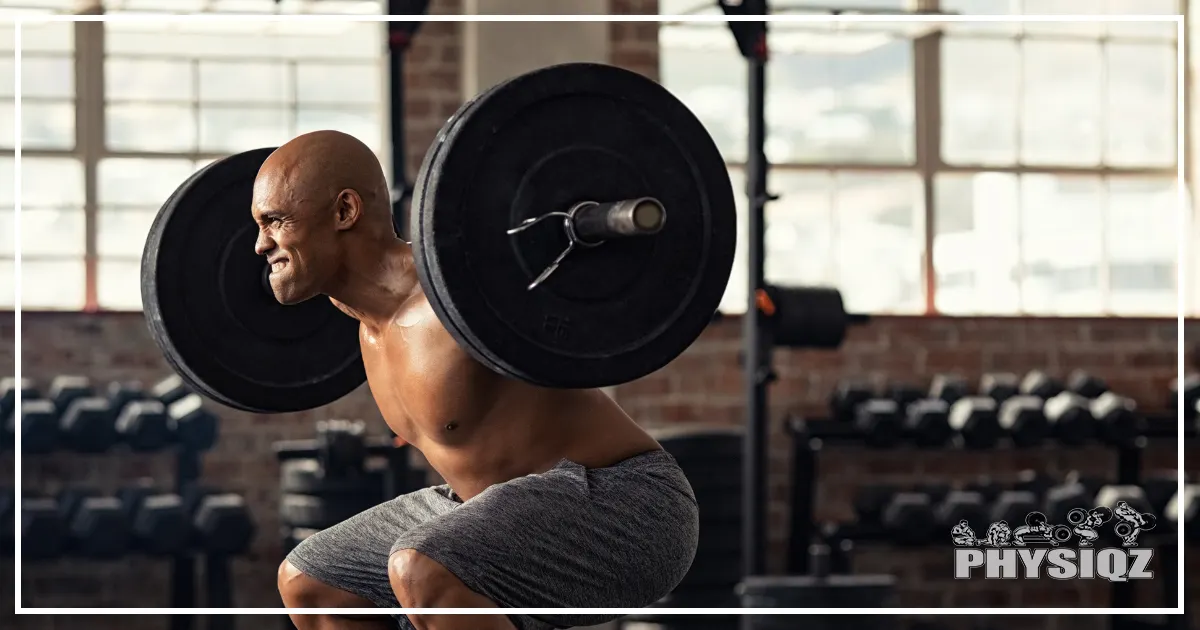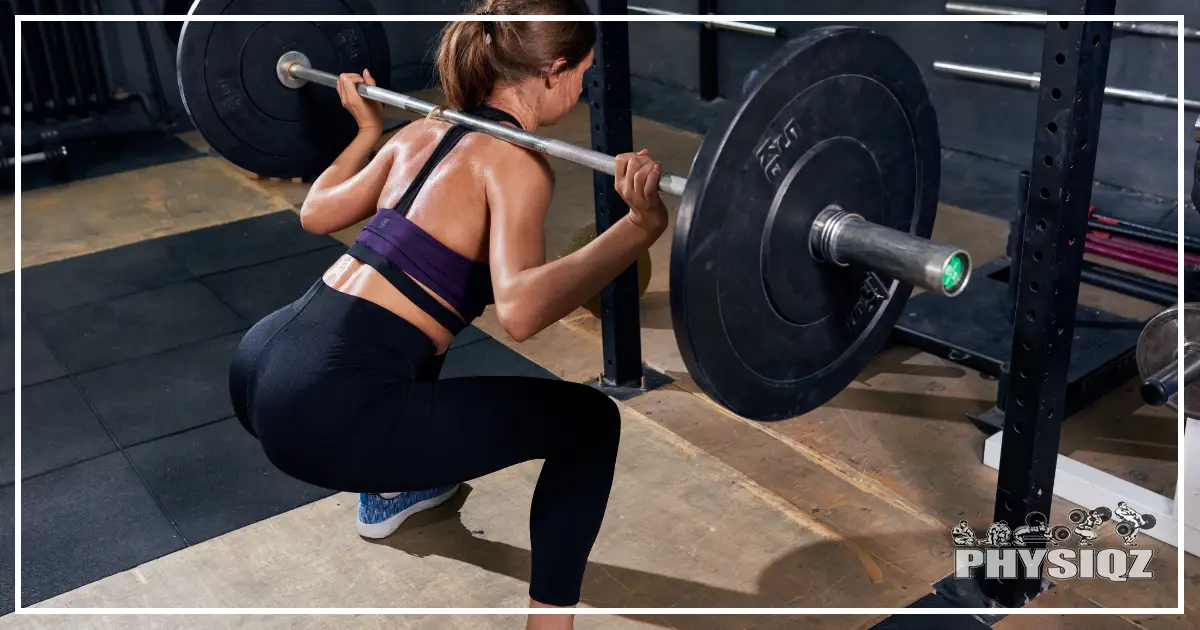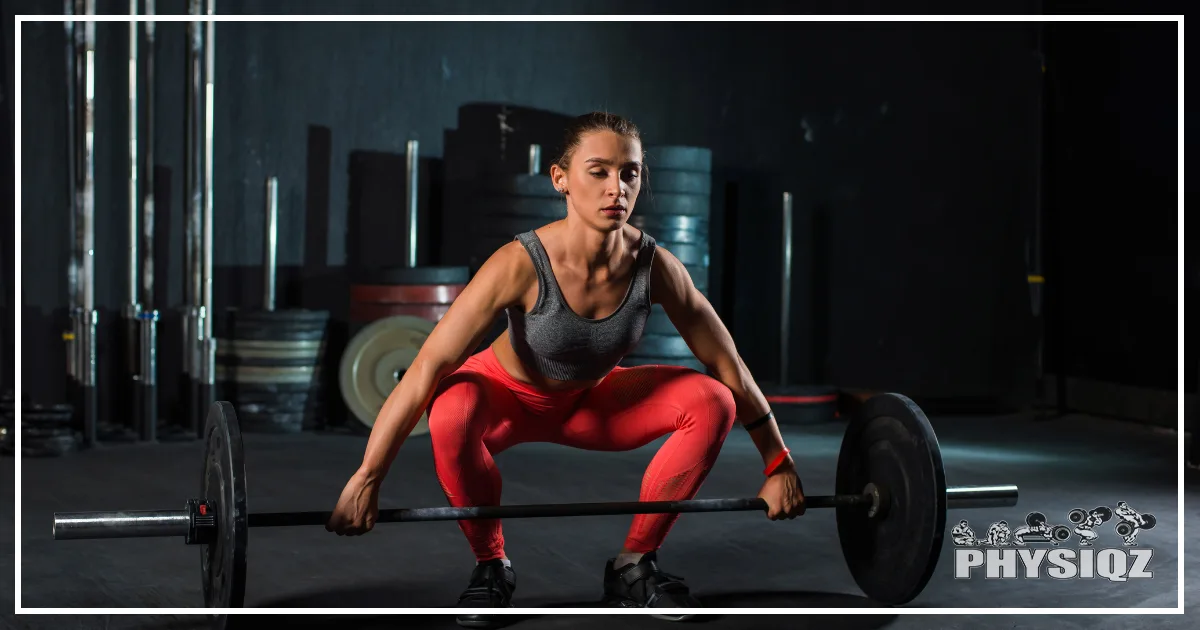
You just got to the gym, and it’s leg day, but you are wondering if you can squat and deadlift same day to increase your workout frequency— consequently freeing up days for other workouts or rest.
The answer depends on your training goals—if someone wants to maximize hypertrophy in both, then probably not. However, you may use this trick below to perform both compound exercises on the same day if the goal is to maximize performance.
Is it Okay to Squat & Deadlift in the Same Workout?
It definitely is okay to squat and deadlift in the same workout, as there is no hazard in incorporating both exercises on the same day; however, deadlifts and squats are both extremely taxing exercises so it depends on what someone is looking to achieve and should be done with caution to avoid injury. As they both take a toll on the body, someone must consider whether they are looking to improve their capacity in each workout, then no.
Those looking to increase performance and stamina can deadlift and squat same day. However, those looking to increase hypertrophy are better off not training on the same day. Conjoining the same exercises on the same day presents some other inherent risks—injury or overtraining, which can compromise both exercises and spill over into the overall training regimen. So the question remains if you should squat and deadlift on the same day.
Should You Squat & Deadlift Same Day?
Whether you should deadlift and squat will always depend on what you want to achieve, as mentioned before. The squat is the king of exercises, and for good reason—squats are part of an individual’s daily life, from sitting to lifting objects off the ground.1
When a squatting exercise is completed, the fatigue, as a result, will unquestionably affect the performance of the deadlift exercise. Therefore, if someone is looking to maximize hypertrophy on the deadlift and the squat, then two should not be done on the same day. But, if the goal is to increase strength and endurance—raw stimulus magnitude, then doing both on the same day actually aids in achieving this objective.
It should be noted that if the lifter is new to the gym or doing these two compound exercises, these individuals should not combine them on the same day.
Why Squatting & Deadlifting Same Day Can Be Beneficial
Squatting and deadlifting on the same day have numerous benefits if performed under certain conditions. The benefits range from increased muscle activation to identifying potential weaknesses. You can definitely deadlift and squat on the same day, and using this trick can enhance your overall training program.
Less Warm Up Time for Whichever Lift is After
When someone hits the gym, the muscles cannot be worked out at full throttle until they have sufficiently been warmed up. An analogy is a cold car engine; it usually has issues starting from being frigid. It’s a common and recommended practice to warm up the muscles before exercising them with some light weights or cardio work. Squatting and deadlifting enlist similar muscle groups since they are both lower workouts—engaging the core, glutes, hamstrings, lower back muscles, and hip flexors.
And as a result, deadlift workout have a poor stimulus to fatigue ratio—this is the hypertrophy adaptation that someone can draw from an exercise in relation to the fatigue it induces – they require a lot of warming up and this can be lessened since the first workout is a form of priming, but lifters should always slowly move up to their working set (the weight they will use for most of their sets and reps).2 As an example, if you just squatted, then when you go to deadlifts afterward, you still want to begin with 95, 135, 185, 225, 275, 315, and so forth until it’s your working weight. These numbers can be adjusted depending on the lifter’s final weight.
Muscle Stimulation is Increased
The squat is a very demanding, complex exercise, forcing the brain and nervous system to engage all the muscles, including stabilizers that the activity demands to complete the movement. Squats require a great range of motion (ROM) from the starting position to the bottom with hips parallel to the ground or even an ‘ass to the grass’ position—position below parallel.
Deadlift workout, on the other hand, have a much smaller ROM, and as a result, deadlifts may tend to be less challenging after a squat.
Weaknesses Will Become Apparent
Gym goers or weightlifters often have areas of the body that they tend to ignore more than others. Oftentimes, one area of the body may receive more attention leading to imbalances. Leg movements may also tend to lead to overtraining of movements. When someone switches to the second compound exercise on the same day, weaknesses will get exposed.

Source: Rido via Canva.com3
Less Sets Needed
As mentioned earlier, squats and deadlifts recruit similar muscle groups. As a result of the fatigue that this will bring about, the second session of exercise can be done with fewer sets and still be effective since they are both using similar muscles.
Recovery Time & Frequency
An obvious benefit of training both compound exercises is much more recovery time. Someone can rest for a whole week before training the two exercises again. However, if the weights of both exercises are relatively light, then it is possible to repeat after 3 days—in this way, the frequency is increased.
Mutual Gains
Compound exercises such as bench presses, squats, etc. will have accessory exercises. As a case in point, squats work out the quads effectively but not the hamstrings as much. Weak hamstrings will, however, compromise the squats. Deadlifts, on the other hand, are a very hamstring-intensive exercise. Therefore, if these two lifts are done on the same day, one will be an accessory exercise for the other.
Potential Drawbacks of Deadlifting & Squatting on the Same Day
There are several potential drawbacks of deadlifting and squatting on the same day since these are both taxing exercises—placing enormous strain on the nervous system and skeletal muscles. As a result, this does add to the adage of wondering if you can squat or deadlift on the same day by using this trick. The outline below analyzes some drawbacks of combining the two exercises.
More Fatigue & Strain
As both exercises target the lower body and place immense pressure on the body, combining the two on the same will cause more fatigue. In most cases, especially if weights were fairly heavy, it is likely that a week will be needed to recover. The posterior chain—glutes, hamstrings, lower back and calves will receive a double dose of fatigue from the tensions that both exercises will bring.
Less Weight from Squat & Deadlift Same Day
Since both these exercises hit similar muscle groups and are both energy intensive, it is unlikely that someone can go heavy on both. Even if an individual goes heavy on one, they will most certainly have to go lighter on the other. It would be more efficient to go lighter on both to get an effective workout.
Less Training Volume & Performance
Similar to the point above, and in retrospect, when these two compound exercises follow each other, the performance of the second is bound to be compromised by the first. Subsequently, the training volume of the second will be reduced and the performance will not be on par if it was executed on a different day.
Risk of Injury
As a result of the body’s fatigue, performing the second compound exercise may lead to injury. For example, after a heavy squat, the hamstrings may be spent, and following this with a big lift could put too much pressure on these muscles—this could result in a hamstring or lower back injury.
Length of the Workout
The workout could be lengthy if someone rests up to 5 minutes between sets. Even if the rest is not that long between sets, it will likely still be longer than, say bicep curls, since these are compound exercises. This adds to a long workout that someone may not have the time for.
When Performing Squats & Deadlifts During the Same Workout is Best
There are some types of lifters or certain performance goals that will benefit from performing a squat and deadlift same day. Those that tend to benefit from squatting and lifting on the same day are:
- Powerlifters—during powerlifting competitions, competitors do a set of compound exercises all in one sitting, i.e., they will usually squat, deadlift, and then bench-press— those who can achieve the highest weights win the competition. It would therefore be practical to prepare their bodies for this kind of stress by going heavy on many compound lifts on the same day.
- Prefer to train less frequently—as stated before, combining these two exercises saves time. If someone chooses not to spend too much time in the gym, this option is undoubtedly the way.
- Experienced squatter and dead lifter—once an individual has spent enough time conditioning the body doing squats and deadlifting, the body is sufficiently prepared for the increased stress of combining the two. This combination may be a natural transition for experienced lifters.
- Preference to reduced training frequency—rather than training squats twice a week, an athlete could choose to combine the compound exercises and still achieve training benefits.
- Desire to replicate powerlifting in training—gym goers may desire to have the same performance as powerlifters without actually participating in any professional competitions. They may replicate these conditions in the gym by deadlifting and squatting on the same day.
- Preference for using accessory exercises— those who prefer working out using accessory exercises will favor this workout style.
When Deadlifting & Squatting Same Day Is Not Ideal
Conversely, this method of training may not be suitable for specific individuals—they are better off exercising on consecutive days or squatting twice a week.
- Bodybuilders—the main goal of a bodybuilder is to gain muscle through progressive strength training. Bodybuilders tend to concentrate on big lifts to maximize hypertrophy; combining these two workouts would not be beneficial due to the apparent strain on the body.
- Desire to focus on one exercise—for someone looking to focus on a compound lift—deadlift or squat, then it is better to train these on alternate days since the object is to pack on muscle by doing either heavy squats or big lifts.
- Body recovers quickly—due to differences in body characteristics, some individuals tend to recover rapidly from intensive exercises. With a shorter recovery cycle, the ability to hit the training with increased frequency is possible. It would be beneficial in these cases to split the exercises.
- Body part split workouts—during body part split workouts, different muscle groups are worked on separate days—known as upper and lower split workouts. For example, someone may train chest and back on the same day and quads and hamstrings the following day. This training system will not be suitable for combining these two compound exercises in one day.

Source: SeventyFour via Canva.com4
Trick #1 To Squat & Deadlift Back To Back: Two-a-Days or Shifting Volume
You can deadlift and squat same day, and the first trick that will allow you to do this effectively without compromising gains and performance would be to incorporate a two-a-day or shifting volume technique— squat and deadlift same daily routine.
Working out twice a day is very beneficial and will increase the stamina of those who engage in it.5 It would also mean that training goals can be accomplished twice as quickly. Since more work is being put in, the implication is that the body will yield much more significant results. Increased training volume almost always results in increased hypertrophy due to the dose-response relationship—more work means more gains.
The trick to doing these compound exercises would be to split the timing, say morning and evening but on the same day—achieving the same day work out. The body will adapt to the stress placed upon it to handle the load, however, this will be to a certain extent. When this threshold is crossed—overtraining kicks in, and the exercises cease to be beneficial.
Ideally, it is better to start with squatting before proceeding to deadlifting. This is because deadlifting is primarily a back exercise and will tax the lower back. Therefore, when moving to squat heavy, the spine may become fatigued and run the risk of injury.
When splitting between the two, the morning sessions would be best programmed using heavy weights with a lower count, and the second session should be lighter weights and higher rep count. For example, someone can choose a max effort squat followed by a deadlift in the next session.
It is also essential to ease into these exercises and gradually build up. Rushing into the training may lead to an increased risk of injury. Conversely, this type of exercise may prevent injury due to the body’s adaptations due to increased stress. Increased effort in a rapid fashion and not giving rest can set up for injuries.6
Trick #2 To Squat & Deadlift the Same Day: Use Variations To Like Sumo & High Bar to Lower Stimulus to Fatigue Ratio
The second trick that will allow an athlete to squat and deadlift on the same day would be to introduce different variations of both the squat and deadlift—using sumo deadlifts and high bar squats to lower the stimulus to fatigue ratio.
The sumo deadlift is a modification of this compound exercise but done with a wide stance. This positioning will allow the lifter to recruit more leg muscles when lifting the weight. As a result, less stress is placed on the lower back, lowering the stimulus to fatigue ratio. This key benefit will allow the lifter to combine the exercise with a squat on the same day with a less fatigued back. The image on the right is a sumo deadlift.
Rack pulls could be incorporated as well. A rack pull is colloquially referred to as a half deadlift. Using the barbell and the squat rack, this exercise mimics a deadlift without the full range of motion, making it less strenuous. This makes it a perfect addition when combining squats and sumo deadlifts on the same day.
Less stress on the lower back implies less fatigue, allowing someone to switch to squats. In addition to this trick, an individual may modify the squat by completing the high bar squat. When performing the high bar squat, the barbell is placed on top of the shoulders—slightly below the C7 vertebrae.
High bar squats tend to induce less muscle activation, especially during the eccentric part of the movement, than low bar squats—when the bar is placed across the shoulder blades, much lower than the high bar.7 Beginners usually employ high-bars due to the relative ease of doing them compared to the low-bar squats. Therefore, this type of squat would be perfect for combining with a deadlift on the same day since it is less challenging.

Source: Reshetnikov_art mrwed54 via Canva.com8
Other Ways To Program Squats & Deadlifts Into Your Routine
There are other ways to program squats and deadlifts into your workout regimen than just working them on the same day.
These programs should complement the training regimens and address weaknesses and imbalances. They are mostly variations of the squat and deadlifts and are usually finishers done at the end of the session once the heavy lifting is complete.
It will be crucial to master the hip hinge as it is the main primary pillar in performing deadlifts. The hip hinge is essentially the hips being the pivot of movement between the thighs and lumbopelvic (lumbar spine and pelvic) section. This ensures a neutral spine and bending only occurs at the hips. These are other ways to program squats and deadlifts in your routine:
- Romanian deadlifts— these will help beginners transition into a full deadlift and are a great accessory to the exercise. They are performed, bringing the weight to just below the knees and not to the ground. Another variation to use would be the single-leg Romanian deadlift which is ideal as it is unilateral. It is excellent for targeting the hamstrings and is performed by balancing on one leg and bending the torso forward with the hips acting as the pivot. It can be done with dumbbells and should ideally be done with toes facing down for added stability.
- Front squats—unlike the conventional back squat, the barbell is supported by the shoulders and the upper chest. This exercise puts effort into the quads and thus develops that well.
- Split squats— these may be done using dumbbells or kettlebells and involve squatting one leg at a time. This is an excellent exercise for addressing muscle imbalances.
- Bulgarian split squats—this is a single-leg squat that addresses imbalances. It is done with one foot placed on a bench while the other is set on the ground and executing the squat while holding dumbbells.
- Smith machine squats—the smith machine is often overlooked, but it is beneficial to incorporate this into the exercises—it removes the need for balance and stability hence focusing primarily on the legs. However, note that smith machine squats do not replicate squat bar patches and should usually be done by leaning back into the bar some.
- Hanging leg raises—this exercise involves raising the knees to hip level while hanging on a bar. This should be completed by pulling them firmly into the chest.
Whether or Not You Should Squat & Deadlift Back-to-Back Depends on Your Goals
In summary, whether or not to squat and deadlift back-to-back will depend on whether someone wants to increase strength and/or stamina vs. increasing muscle mass. You can squat and deadlift on the same day using this trick, but if it doesn’t align with your training goals, it’s not necessary.
Those with pure hypertrophy goals—muscle building would likely not use this training method due to the inability to lift heavy and max out in either of the compound exercises. This program is ideal for powerlifters and those seeking performance.
If someone does combine these intensive compound exercises, it would be beneficial to get plenty of rest between sessions, incorporate good weight loss diets, sleep, and recovery techniques such as massage, foam rolling, etc.
Those looking to boost strength and stamina would be pleased to know that you can squat and deadlift same day and use this trick to accomplish this; moreover, you can do it safely and increase endurance to achieve training goals.
Frequently Asked Question
Can You Bench Squat and Deadlift on the Same Day?
Yes. Bench squats are great for those with knee problems since the squats are not deep, and there is no worry of knees collapsing at the bottom. As a result of this, they are less challenging, which makes combining a bench squat and deadlift sensible.
References
1Medicine, N. L. (2014, December 1). The back squat: A proposed assessment of functional deficits and technical factors that limit performance. Retrieved 2022, from www.ncbi.nlm.nih.go: <https://www.ncbi.nlm.nih.gov/pmc/articles/PMC4687103/>
2Medicine, N. L. (1994, September 26). Fatigue contributes to the strength training stimulus. Retrieved 2022, from pubmed.ncbi.nlm.nih.gov: <https://pubmed.ncbi.nlm.nih.gov/7808251/>
3Rido. “Man Lifting Weights at Gym.” Canva. Accessed 7 April 2023. <https://www.canva.com/photos/MADdwgBinVU-man-lifting-weights-at-gym/>
4SeventyFour. “Back View of Woman in Shoulder Squat.” Canva. Accessed 7 April 2023. <https://www.canva.com/photos/MADF96huw3g-back-view-of-woman-in-shoulder-squat/>
5Medicine, N. L. (2015, December 21). Glycogen availability and skeletal muscle adaptations with endurance and resistance exercise. Retrieved 2022, from www.ncbi.nlm.nih.go: <https://www.ncbi.nlm.nih.gov/pmc/articles/PMC4687103/>
6Medicine, B. J. (2003, October). Risk factors for sports injuries — a methodological approach. Retrieved 2022, from bjsm.bmj.com: <https://bjsm.bmj.com/content/37/5/384>
7Medicine, N. L. (2020, June 8). Muscle activation varies between high-bar and low-bar back squat. Retrieved 2020, from www.ncbi.nlm.nih.gov: <https://www.ncbi.nlm.nih.gov/pmc/articles/PMC7289144/>
8Reshetnikov_art mrwed54. “Young, European, Muscular Girl in Red Leggings, Doing Exercise with a Barbell in the gym for Crossfit Dark Background.” Canva. Accessed 7 April 2023 <https://www.canva.com/photos/MAEfYFe3JTE-young-european-muscular-girl-in-red-leggings-doing-exercise-with-a-barbell-in-the-gym-for-crossfit-dark-background/>